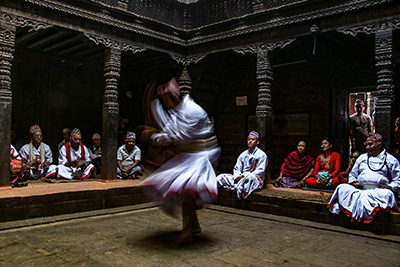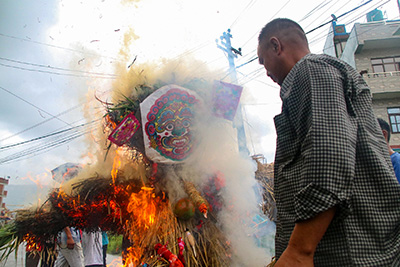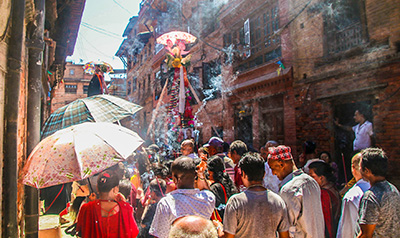Fieldwork
My study explores the unexpected interconnections between devotional life and post-earthquake reconstruction in Bhaktapur, Nepal, one of the world’s most distinctive reconstruction sites, where a Communist municipal government has committed the locality’s resources to the rebuilding of worship sites. My project is concerned with the remarkable initiatives to rebuild the many structures that were demolished in the 2015 earthquakes, being undertaken in Nepal’s most important centre of spiritual activity and principal international tourist destination. My key focus is on understanding how rebuilding projects are experienced as affective spiritual initiatives, and how restoration activities relate to my interlocutors’ perception of the city’s entwining of material and sacred geographies. My fieldwork documents the interaction between devotees for whom the city is a site of multiple interacting devotional sites and traditions, and groups of officials whose concerns are with the city as an officially valorised heritage site. I explore the complex temporality of my interlocutors’ lives as contributors to the city’s rebuilding schemes, which they pursue as a matter of their personal interest, as earthquake-affected residents, and as devotees who seek protection from local deities.
[Note: The photographs are from different festivals celebrated in Bhaktapur, but a theme of renewal is common to each of the images.]
Practicing Spiritual Dancing
This is a photograph of a dancer in performance at the Nava-Durga Temple courtyard during the festival of Ganesh Chaturthi or Cho:tha. The Nava Durga Gana are members of the Banmala community, who traditionally engaged in the flower-selling profession. Members of the community are exclusively entitled to participate in the ritual of wearing elaborate painted masks that represent the Nava Durga or the nine demonic goddesses who protect the city of Bhaktapur. In wearing the mask and performing a dance, the dancers embody the goddesses and attain a status of spiritual superiority, despite their lower-caste status. However, this is the only occasion the dancer performs publicly without a mask. Nava Durga masks are destroyed and created every year as symbol of renewal and on the occasion of Ganesh Chaturthi, these masks are still in the making. Crucially, this is an initiation ceremony where new dancers practice the act of dancing like the Goddess. In the photograph, we see a first-timer dancing in front of an audience of musicians, residents, and experienced Nava-Durga dancers. He doesn’t dance perfectly but is expected to imagine what it would be like to embody the goddess once he wears the mask representing her. The image attempts to portray the dancer as he moves around the temple courtyard in a state of frenzy, while the audience, sit still, encouraging and appreciating him.
Burning Demon Effigies
The festival of Gatha Mugha Cha: Re is celebrated every year to mark the beginning of the cycle of festivals and rituals in Bhaktapur. During this occasion, families in each of the city’s neighbourhoods build an effigy of the malicious demon Ghanta Karna, who represents evil energies, out of straw, bamboo, and wood. They paint faces on the effigy to convey the demon’s unpleasant face and make phallic symbols with coconuts and woof to make it appear lifelike. The anthropomorphic demons are made to circumambulate a fire in neighbourhood and then carried outside the city’s traditional boundaries, typically by male residents(as shown in the photograph), who hurl abuses at the effigy and then burn it at the first crossroad they encounter. This symbolises the cleansing of contaminating forces that accumulated over the year in sacred space of the neighbourhood. While many residents now live outside the city’s traditional boundaries that historically separated sanctified neighbourhoods protected by local deities from its polluted peripheries, festivals and rituals continue to reinforce this distinction, complicating the notion of a sacred city and the practices that (re)define it.
Celebrating the Deceased
This is a photograph of residents in procession during the festival of Saparu or Gai-Jatra, celebrated to honour those who have passed away. Families who have lost a member(s), must lead a cow or a calf in procession, as these animals are believed to guide the souls of the dead and help them transition to heaven painlessly. Alternatively, families who cannot afford a cow, participate in the ritual by building a symbolic structure of a cow using bamboo and wood and parade the structure on a designated sacred path. Families do not mourn the loss of their loved ones, but rather are expected to celebrate death and afterlife by engaging in merrymaking through satirical dramas and dance. In the photograph we see a family joined by distant relatives and friends carrying the symbolic cow through a neighbourhood. The symbolic cow is offered flower garlands, and a picture of the deceased relative is attached to the structure. They burn incense and sing songs to the dead, acknowledging the cycle of life and rebirth. The festival is celebrated in the middle of the monsoons, which is why people are carrying umbrellas. It marks the season when farmers replant seeds of rice, and thus also renews the city’s agrarian cycle.



